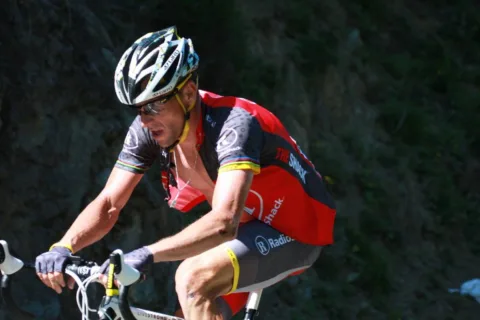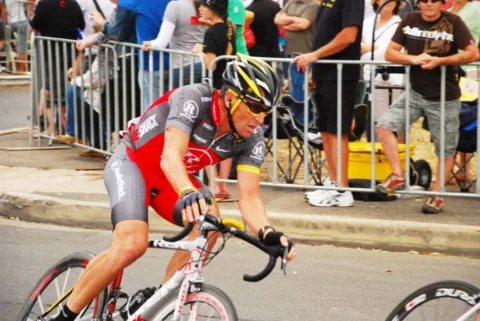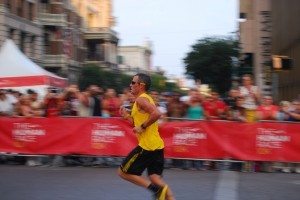Triathlon is a multi-sport: swim, bike, run.
The longest leg of every triathlon is biking.
If you aspire to do an Ironman, that means 112 miles on a bike. Become a first-rate cyclist and you are on your way to becoming a successful triathlete.
Do you want to bike like Lance?
Sorry, I can’t help you there; there’s only one Lance Armstrong.
But I can do the next best thing, which is to tell you the secret to Lance Armstrong’s training.
The Secret To Lance Armstrong’s Training
You need to improve your ability to ride at your lactate threshold.

Here’s how to do that…
Chris Carmichael, Lance Armstrong’s coach, explains:
“Power isn’t the issue. Anyone can produce 400 watts for a few seconds. However, most riders can’t produce 400 watts for a very long time without going anaerobic and slowing abruptly. What’s key is the ability to produce significant power while remaining under your lactate threshold (LT) and in control. All of Lance’s training revolved around raising his power at LT. The secret is to do most of your hard training a little below, at, or slightly above your lactate threshold.”
Let’s break this down for further understanding…
The Lactate Threshold (LT) is the point during exercise of increasing intensity at which blood lactate begins to accumulate above standard levels. This is sometimes also referred to as Anaerobic Threshold (AT).
To produce energy for movement, the muscles primarily use fat and carbohydrate for fuel. When carbohydrate – the sugar-based fuel source – breaks down, lactic acid is produced in the muscles. As it seeps out of the muscle cell and into the blood, hydrogen ions are released and the resulting salt is called “lactate.” This is most commonly referred to as “lactic acid,” which is a by-product of the lactic acid system resulting from the incomplete breakdown of glucose (sugar) in the production of energy.
As the intensity of exercise increases, the amount of lactate also increases. At low levels of production, the body efficiently removes and recycles lactate. The level of exertion at which the body shifts from aerobic to anaerobic is marked by such rapid lactate production that the body can’t keep up with its removal. Lactate begins to accumulate in the blood, interfering with energy production and muscular contractions, which causes fatigue. The level of intensity at which accumulation of lactate begins is called the “lactate threshold.”
One of Lance Armstrong’s training secrets was to invest a lot of time cycling right at this lactate threshold point. By doing so, he trained his muscles to maintain a high force load for a prolonged time. This improved his body’s capacity to process lactate, conserve fuel sources, and resist fatigue – all of which come in handy when you are biking 2,200 miles across France.
Do you see why this would be critical for a triathlete?
Triathlon is about muscular endurance. This would especially be true for longer distance triathlons such as the 70.3 Ironman and the full Ironman.
As Lance’s coach said, anyone can be strong for a relatively short period of time, but it is a whole other thing to exert and maintain a significant level of force over a long period of time. In order to do that, your body’s capacity to process lactate and resist fatigue must be improved.
How do you improve your body’s capacity to do these things?
You do what Lance did: high intensity training.
Many triathletes assume that what they must mostly do in their triathlon training is swim, bike, and run for long periods of time, covering increasing blocks of mileage. The more the merrier! So they find a comfortable stoke, or cadence, or pace and lock it in for miles and miles or hours and hours.
It is true that establishing an endurance base in swimming, biking, and running is a critical part of a periodization triathlon training plan. However, laying an endurance base is only one part of the plan.
Is a house complete once its foundation is laid? Of course not! Next time you drive by a new housing development just getting under construction, notice all the foundations that have been laid yet to be built upon. Sadly, this image describes a lot of triathletes – they have laid an endurance foundation but they have not built anything upon it.
The main objective of this post is to convince you of one thing…
Triathlon training is not just about how far you can go. Triathlon training is about how hard you can go for how long.

This was the main premise of Lance Armstrong’s training. It wasn’t just if he was capable of lasting on a bike for 2200 miles, but how much power he was capable of generating and maintaining over those 2200 miles. Answer: more than anyone else!
Triathlon training is about endurance and intensity. Both are equally important, and you must train the body for both. Endurance training won’t accomplish what intensity training accomplishes. Intensity training won’t accomplish what endurance training accomplishes.
This is why the sport of triathlon is so unique, compelling, and demanding. A sprinter exerts force for a short period of time, and an ultra marathoner can run ‘til the cows come home. But a triathlete is trying to train their body to be a fusion of both power and endurance.
Intensity training for a triathlete applies to all 3 areas: swimming, biking, and running. The simplest way for the self-coached triathlete to begin intensity training is to understand that while endurance training is finding a comfortable stroke rhythm, cycling cadence, or running pace and locking it in for long periods of time, intensity training is about raising your level of exertion to a point of discomfort, and training your body to perform at this point for increasing amounts of time.
The 5 Intensity Zones
In a nutshell, it is commonly accepted that there are 5 Intensity Zones:
- Zone 1/Recovery: Low intensity, easy, body rejuvenating zone.
- Zone 2/Extensive Endurance: Long endurance, conversational-level zone.
- Zone 3/Intensive Endurance: Increase of intensity, lactate production rises.
- Zone 4/Threshold: Just below or slightly above lactate threshold, discomfort, anaerobic.
- Zone 5/Anaerobic Endurance: Intensity now exceeds the lactate threshold.
All the zones have their place in triathlon training. Other than Zone 2/Extensive Endurance, Zone 4/Threshold is the most important training zone for the triathlete.
Which zone are you in?
There are various ways one can determine which intensity zone they are in. A very common way is by using a heart monitor. Another method is using what is commonly referred to as the Rate of Perceived Exertion (RPE).
The idea is to listen to your body and assess the level of exertion based on sensations emanating from the body’s many physiological systems.
The Borg rating was created to assist the athlete in determining their RPE. The system assigns a numeric value to increasing levels of exertion based on how they feel. You would apply the Borg rating as follows:
- Zone 1: 6-8 RPE
- Zone 2: 9-11 RPE
- Zone 3: 12-14 RPE
- Zone 4: 15 RPE
- Zone 5: 16-20 RPE
In a year-round triathlon training plan based on the principle of periodization, once you have laid a significant endurance base in the areas of swimming, biking, and running, the focus increasingly shifts to intensity training.
Intensity training involves intervals, which are set times or distances that you operate within Zone 4. There are many different ways of doing interval training, which includes gradually increasing the time or mileage you are working in Zone 4 and/or decreasing the amount of recovery time between each interval.
You will need to do some research to establish intensity training sessions in swimming, biking, and running respectively. The primary point right now is you realizing that you must incorporate intensity training (lactate threshold training) into your triathlon training.
If you want to apply the training methodology that helped Lance succeed as a cyclist, you can’t just do Zone 2 all the time. Proper intensity training is critical! Please notice the word “proper.” Intensity training is often where triathletes make overtraining mistakes, which can cause injuries.




